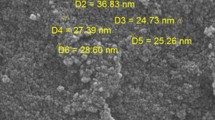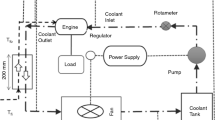Abstract
Nanofluids have been extensively studied in the past to enhance the heat transfer performance and efficiency of systems. However, corrosion effects have been paid very little attention and thus this work presents an experimental study on the effect of carbon nanotubes (CNT) on corrosion of three different metals under study such as aluminium alloy, stainless steel and copper, respectively. The work was further extended to study the heat transfer performance in a car radiator of two different sizes. Both the studies were performed using four different fluids such as water, ethylene glycol, 0.02 % CNT-nanofluid and 0.1 % CNT-nanofluid, respectively. It was observed that among the three metals, the highest rate of corrosion occurs to aluminium, followed by stainless steel and copper, irrespective of the fluid used. The rate of corrosion increased with the increase in temperature (27–90 °C) in all cases. The experimental results showed that the stable CNT-nanofluids prepared in this work showed better heat transfer performance in both engines. Moreover, the smaller radiator using the CNT-nanofluids depicted enhanced heat transfer rates compared to the standard radiator using water and ethylene glycol.










Similar content being viewed by others

References
Choi SUS (1995) Enhancing thermal conductivity of fluids with nanoparticles. In: Siginer DA, Wang HP (eds) Developments and applications of non-newtonian flows. ASME, New York, pp 99–105
Taylor R, Coulombe S, Otanicar T et al (2013) Small particles, big impacts: a review of the diverse applications of nanofluids. J Appl Phys 113:011301–011319
Fan J, Wang L (2011) Review of heat conduction in nanofluids. J Heat Transfer 133:040801-1–040801-14
Yu W, Xie H (2012) A review on nanofluids: preparation, stability mechanisms, and applications. J Nano Mater. doi:10.1155/2012/435873
Wang XQ, Mujumdar AS (2008) A review on nanofluids—part I: theoretical and numerical investigations. Braz J Chem Eng 25:613–630
Kakaç S, Pramuanjaroenkij A (2009) Review of convective heat transfer enhancement with nanofluids. Int J Heat Mass Transfer 52:3187–3196
Lee JH, Lee SH, Choi J, Jang SP, Choi SUS (2010) A review of thermal conductivity data, mechanics and models for nanofluids. Int J Micro-Nano Scale Transp 1:269–322
Dresselhaus MS, Dresselhaus G, Charlier JC, Ernandez EH (2004) Thermal and mechanical properties of carbon nanotubes. Philos Trans R Soc Lond A 362:2065–2098
Ding Y, Alias H, Wen D, Williams RA (2006) Heat transfer of aqueous suspensions of carbon nanotubes (CNT nanofluids). Int J Heat Mass Transfer 49:240–250
Rashmi W, Ismail AF, Khalid M (2012) Thermal conductivity of carbon nanotube nanofluid-Experimental and theoretical study. Heat Tran Asian Res 41:145–163
Xie H, Lee H, Youn W, Choi M (2003) Nanofluids containing multiwalled carbon nanotubes and their enhanced thermal conductivities. J Appl Phys 94:4967–4971
Rashmi W, Khalid M, Ismail AF, Saidur R, Rasheed AK (2013) Experimental and numerical investigation of heat transfer in CNT nanofluids. J Exp Nanosci. doi:10.1080/17458080.2013.848296
Rashmi W, Ismail AF, Sopyan I, Jameel AT, Yusof F, Khalid M (2011) Stability and thermal conductivity enhancement of carbon nanotube nanofluid using gum Arabic. J Exp Nanosci 6:567–579
Liu MS, Lin MCC, Huang IT, Wang CC (2005) Enhancement of thermal conductivity with carbon nanotube for nanofluids. Int Commun Heat Mass 32:1202–1210
Khomami MN, Danaee I, Attar AA, Peykari M (2012) Effects of NO2 − and NO3 − ions on corrosion of AISI 4130 steel in ethylene glycol+water electrolyte. Trans Indian Inst Met 65:303–311
May PM, Ritchie IM, Tan ET (1991) The corrosion of copper in ethylene glycol–water mixtures containing chloride ions. J Appl Electrochem 21:358–364
Liu Y, Cheng YF (2009) Cathodic reaction kinetics and its implication on flow-assisted corrosion of aluminum alloy in aqueous ethylene glycol solution. J Appl Electrochem 39:1267–1272
Liu Y, Cheng YF (2011) Characterization of passivity and pitting corrosion of 3003 aluminum alloy in ethylene glycol–water solutions. J Appl Electrochem 41:151–159
Liu Y, Cheng YF (2011) Inhibition of corrosion of 3003 aluminum alloy in ethylene glycol–water solution. J Mater Eng Perform 20:271–275
Niu L, Cheng YF (2007) Electrochemical characterization of metastable pitting of 3003 aluminum alloy in ethylene glycol–water solution. J Mater Sci 42:8613–8617. doi:10.1007/s10853-007-1841-1
Celata GP, D’Annibale F, Mariani A (2011) Nanofluid flow effects on metal surfaces. Energ Ambiente e Innovazione 4–5:94–98
Singh D, Toutbort J, Chen G, (2006) Heavy vehicle systems optimization merit review and peer evaluation. Annual Report, Argonne National Laboratory, USA
Sahoo RR, Bhattacharjee S, Das T (2013) Development of nanofluids as lubricant to study friction and wear behavior of stainless steels. Int J Mod Phys Conf Ser. doi:10.1142/S2010194513010829
Arthur DE, Jonathan A, Ameh PO, Anya C (2013) A review on the assessment of polymeric materials used as corrosion inhibitor of metals and alloys. Int J Ind Chem. doi:10.1186/2228-5547-4-2
Kesavan D, Gopiraman M, Sulochana N (2012) Green inhibitors for corrosion of metals: a review. Chem Sci Rev Lett 1:1–8
Rani BEA, Basu BBJ (2012) Green inhibitors for corrosion protection of metals and alloys: an overview. Int J Corros. doi:10.1155/2012/380217
Author information
Authors and Affiliations
Corresponding author
Rights and permissions
About this article
Cite this article
Rashmi, W., Ismail, A.F., Khalid, M. et al. Investigating corrosion effects and heat transfer enhancement in smaller size radiators using CNT-nanofluids. J Mater Sci 49, 4544–4551 (2014). https://doi.org/10.1007/s10853-014-8154-y
Received:
Accepted:
Published:
Issue Date:
DOI: https://doi.org/10.1007/s10853-014-8154-y



